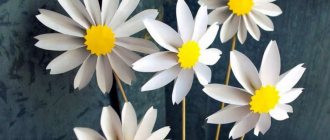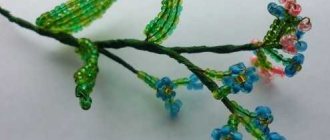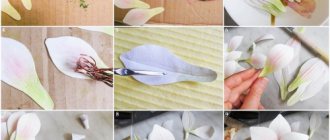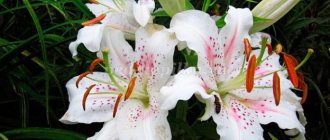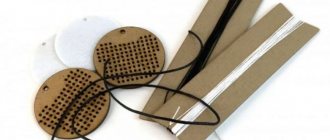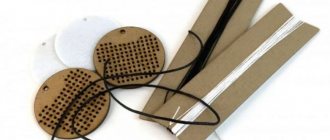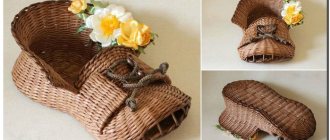Step-by-step photo lesson:
Take a sheet of yellow paper and begin to create the bottom layer of petals. They will be the longest. Their length will be 21 cm, and their height will be only 1 cm. 18 such strips should be cut out.
Now we glue them together in droplets using office glue.
Cut out a circle from yellow paper, the diameter of which will be 3-4 cm. Glue all the petals of the first tier onto it.
Now let's move on to the second layer and cut out nine strips of paper 15 x 1 cm.
Glue them together in the form of droplets and let them dry.
We attach nine petals to the center of the aster, which will create a second layer.
A third tier should definitely be created. Therefore, we will cut out nine strips of 10 x 1 cm.
Glue them one by one to the very center of the flower.
Finally, let's make the last layer of petals. They will be both shorter and narrower. To do this, take a sheet of yellow paper and cut out five stripes 6 x 0.5 cm. Glue them in the middle of the flower.
Not a single flower is complete without a leaf. Therefore, we cut out a large sheet of green paper and glue it to the back.
Now the paper aster is ready. Such a bright and voluminous craft will certainly decorate your home and attract the attention of every guest.
Panel: Asters for decorating a group in kindergarten on September 1st.
Master class with step-by-step photos. Chasovskikh Svetlana Olegovna.
Purpose: Decoration of the group for the holiday “Day of Knowledge” Purpose: Making panels from colored paper using the quilling technique. Objectives: Continue to introduce the quilling technique. Teach new techniques for working with paper: carefully cut strips of paper with “grass.” Improve the ability to roll strips of paper into a tight roll. Cultivate perseverance and accuracy. Develop fine motor skills of the hands. Develop children's compositional skills. Asters Earthly stars, so familiar. Asters are simple, double... Various. Unusual in their diversity.
Near the houses, a low picket fence, whitened by thunderstorms, is leaning from old age, And in the front gardens - from time immemorial, I remember - Asters in fawn and pink constellations.
The day will flash by unfamiliar faces. The sun is falling with ripe Antonovka. At dusk, the last lightning will flash Blue asters, burgundy, white...
Motley autumn lives with carnivals, Extending summer into stormy weeks, Pampering with bright days and colors - Purple, yellow, red asters... Author: Elovikova Diana.
Asters are the last smile of autumn. These unpretentious flowers evoke different feelings in people: joy and sadness, because winter is about to come. Asters can withstand frosts down to -7 degrees. There is a belief: if you stand among the asters at night and listen carefully, you can hear a subtle whispering - this is how asters communicate with their sisters - the stars in the sky. This is not surprising, because according to legend, the aster grew from a speck of dust that fell from a star. This legend was originated by the Parisian astronomer Alexandre Henri Gabriel Cassini. As a young man, Cassini studied the science of celestial bodies, but devoted his entire life to botany. In 1826, he isolated a new genus from the aster family - callistephus, which translated from ancient Greek means “beautiful flower”. In flower science practice, callistephus are called annual or Chinese asters, and true asters are called perennials. The aster flower is a symbol of women born under the astrological sign of Virgo. Aster is a symbol of sadness. This flower was considered a gift to man from the gods, his amulet, amulet, a piece of his distant star. Therefore, the sadness it symbolizes is sadness for the lost paradise, for the inability to rise into the sky.
Autumn over the shady park... The gold of the maples lies on the waters of the pond. The leaves are spinning... The birds have fallen silent... Aster looks into the cold sky, a radiant aster - a star.
The aster with its straight petals has been called a “star” since ancient times. That's what you would call it yourself. The petals in it scattered like rays
From the core it's completely golden. Dusk is approaching. Subtle and sharp Light sways in the sky of the constellations. An aster in a flowerbed, fragrant and colorful, watches the distant sisters shine, and sends them greetings from the earth. (Sunday Christmas)
The mysterious light of a star is not the same: sometimes it is pinkish, bluish, sometimes golden, and the stars also twinkle.
Romantically minded people are sure that the stars transmit signals to the Earth with their twinkling and receive them in return. And sometimes, stars fall from the sky and fall down. Ancient people began to look closely at the trees and flowers on the ground, trying to find out where she was, the fallen mysterious beauty? And they saw small flowers, blue, with yellow circles in the middle, and then they realized - here it is - a star, swaying from a light breeze! This flower came to Europe, or more precisely to France in 1728, from China. It took a whole 22 years for the first terry aster to appear! The genus of asters has several hundred species. The simplest asters resemble daisies, and there are stunningly beautiful peony-shaped asters. These flowers are annual and perennial, blooming from late summer until frost. Aster is an autumn flower. Among the asters there are both low and tall, their inflorescences have all kinds of colors: snow-white, blue, cream, yellow, dark red and even multi-colored! According to the structure of the inflorescences there are: peony-shaped, rose-shaped, chrysanthemum-shaped. The inflorescences can be small, or can reach 17 or more centimeters in diameter. Aster is a very ancient plant. The ancient Greeks considered it an amulet. In the language of flowers of Hungary, the aster represents autumn and is called “ostiroza”, which translated into Russian means “autumn rose”. Materials required for work:
Colored paper of different colors, scissors, glue, quilling tool or toothpick, frame and shampoo bottle (optional).
Step-by-step process for making the work:
To make asters, you need to cut strips of paper with a width of 2,3,4, and 5 centimeters. If you need to make smaller flowers, you can skip the size of 3 centimeters, since it goes into the middle and does not affect the size of the petals. Glue the strips together into one long strip. If we want to make the centers of a different color, then the 2 and 3 centimeter strips should be of a different color. Cut one edge of the strip finely, “grass,” as we call it with the children. We cut the edge that is not smooth, then we will twist the smooth one. Take a quilling tool or a toothpick and start twisting from a side of 2 centimeters. We twist it as tightly as possible so that the flower does not crumble. We remove the twisted flower, seal the edge, and coat the bottom with glue. Only after this we begin to “fluff” the petals. This process must be done very carefully and therefore preschoolers at this stage need the help of an adult. Using scissors, we twist the petals 4 centimeters inward and 5 centimeters outward. I drew the leaves myself, folded a sheet of paper like an accordion, traced the leaf and cut it out. I folded the leaf in the middle and along the veins to give it volume. I made the frame myself from gray packaging cardboard. I painted the frame and glued wallpaper in the middle.
I decorated the frame with strips of corrugated cardboard.
I cut a bottle of suitable shape to the height I needed.
Asters are perfect for creating chic bouquets and compositions. The variety of shades and shapes of these flowers is simply huge, which allows you to create even the most complex compositions. In addition, autumn “stars” are very versatile plants that fit into any bouquet, organically combining with even the most exotic flowers. In today's master class we will show you how to make asters from corrugated paper with your own hands.
Volumetric flowers
Using the method described above, you can make large lush asters with your own hands from corrugated paper. The main flower is also cut out from a long rectangle, only the edges of one of its sides are cut not with a straw, but with a wide “noodle”. Then there will be scrupulous and painstaking work on cutting off the corners on each part. You should get pointed aster petals.
When everything is ready, the bottom of the rectangle is twisted around the rod and the edge is glued to the last turn in the same way. Further work continues on the creation of sepals. A circle is cut out of green corrugated paper, and the edges are cut into large petals, without affecting the central part of the craft. At the end, you can attach another small circle for strength.
Chrysanthemum
How to make such a lush chrysanthemum with its huge number of small petals? And how to choose a color scheme to make the model look like it’s alive? This detailed MK is about this.
We will need:
- 3 shades of blue crepe paper;
- Dark and light green for leaves and stems;
- Tube (from foil or paper towels);
- Scissors;
- Ruler;
- Glue gun;
- Circle made of cardboard, diameter 32-35cm;
How to do:
The outer leaves are the darkest. We cut strips 50-51cm wide along the entire length of the roll.
We cut each such strip into 25-25.5 cm. And then we cut the rectangles in half.
Fold each rectangle in half. Cut off the corner at the base of each petal. We cut the other side to make 3 parts with rounded edges. The middle part is slightly longer than the sides.
We stretch the petal a little along the edge, and then in the middle.
We glue all these petals along the edge of the cardboard circle, at a short distance from each other.
The next ball of petals is glued in a checkerboard pattern. Between the petals of the first circle.
We cut out similar petals from lighter paper and glue them to the base, alternating with dark petals.
From the next roll we cut rectangles 16 by 6 cm. Cut the corner from the bottom. On top – fold it in half and make a semicircle and a deep cut. As a result, we get an elongated heart.
We straighten the workpiece, stretch it and give it a shape; for this we stretch the edge of the petal and the middle. The petals seem to curl a little into a tube.
Glue between the petals, in a checkerboard pattern. We make 2-3 rows.
Cut a strip 13 cm wide into 3 cm pieces.
In each piece, cut off a corner from one edge. Stretch it in the middle, keeping the corner sharp.
And we make exactly the same blanks from light blue.
Glue the first row alternating these 2 colors.
The sharp corners of the petals should not lie down, they should stick up. This will provide volume and splendor to the structure.
The next row is only blue.
And the next one is only made of light paper.
Then a combined row of light and light green colors.
This is what our flower looks like.
For the middle we will need exclusively light green blanks measuring 13 cm by 3 cm and with a cut edge. And we will only stretch it in length. Using pressure, we draw across the workpiece with a ruler or scissors. Then the petal will curl a little, like a curl. But we only need the workpiece to take the shape of an arc.
We glue these blanks in several layers onto the edge of the cardboard tube (we cut off a part from the tube).
The last rows can alternate green petals with blue ones.
Cut out the empty center of the cardboard circle crosswise.
Fold the edges under and insert the pipe into the hole.
On the back side of the cardboard, glue the pipe to the bent edges and wrap it with tape.
Cut out 6 rectangles of 20 by 25 cm from dark green paper.
From each rectangle we cut out a leaf and stretch it a little along the edges and in the middle. These are sepals.
We glue them on the back side of the flower to the cardboard circle, overlapping each other.
Cut out a thin ribbon (3cm wide) from dark green paper. We stretch it a little in length.
We wrap the pipe with tape and place it on the glue.
We insert a PVC pipe into the tube. We also wrap it with tape.
To make a leaf, cut out a square. Cut it diagonally.
Glue it diagonally onto one half with wire. Cover the wire with the other half, gluing it on top.
Cut out a chrysanthemum leaf.
We bend and stretch the edges, forming the shape of a leaf.
We fix the edge of the leaf with glue and tape to the pipe.
Don't like blue chrysanthemums or want a lot of different chrysanthemums? Then take as a basis how such flowers are made and create something new, your own!
Author MK
Aster
In this master class we will look at how to make flowers with very thin petals, for example, like those of an aster.
We will need:
- Lilac paper: 5 pcs. – 16 cm by 1 m, 3 pcs. – 20 cm by 1 m, 5 pcs. – 24 cm by 1 m.
- Pink: 10 cm by 1 m.
- Pliers;
- Wire;
- Glue gun;
- Scissors.
Making:
We bend a strip of 16x100 cm in half. We cut off the edge with sharp teeth.
Glue the wire inside along the fold line. And slightly gather the paper into a small fold.
We do everything exactly the same with strips 20 and 24 cm wide.
We cut the pink paper into strips (fringed), without cutting to the edge, and roll it into a roll.
We begin to assemble the structure from the middle. We twist the pink blank.
Glue this blank to the edge of lilac paper (16 cm wide).
Twist and glue the pink lilac blank around it. And so all 5 parts.
Then we twist the workpiece larger (3 parts).
And at the end we twist a large blank (5 parts), the width of which is 24 cm. Be sure to glue the base of the flower for better fixation.
Decorate the bottom with paper.
Where is such beauty? You can decorate a room for a holiday or a studio for a photo shoot. Due to double fixation: wire and glue, the flowers will retain their shape and attractive appearance for a long time.
Author MK
Astra and the basis for it
There were some things I liked about this master class. How to make the basis for an aster from waste material, a simple bottle. Very interesting formation of petals and sepals. Similar to the previous master class, but there is a difference.
For example, the edges of the petals may remain curled. And this gives lightness to the design. It’s interesting how the craftswoman collects and fixes the petals to the base. And the base is a plastic bottle. The result was a fantastically beautiful, huge flower!
Simple but interesting petal shaping
Here I will show you how to shape the petals, giving them the shape of a real, living flower. It seems to me that this flower also looks like an aster.
Cut the roll in half widthwise.
Cut 20 cm. Fold in half 3 times to get 8 peony petals. Cut off the corners on top.
We cut the rectangles along the fold lines, but do not cut the paper completely, leaving 2-3 cm to the edge.
Without unfolding, we twist the paper (like we twist linen). One way and then the other.
Unfold once and scroll 4 more petals together.
Unfold and stretch the middle of each petal.
We glue 2 such strips to each other in a checkerboard pattern. It is necessary that the petals of one strip are located between the petals of the second strip.
And such blanks can already be twisted to make peonies.
More details on the author's video:
And the same method, but different design.
More options you can try to make. The first of them is according to the method described in this section. But here it’s a little more fluffy and we’ve chosen light and dark pink for the middle.
In the next photo, the lower aster contains petals of different lengths and due to this, a completely different interesting look is obtained.
Author
